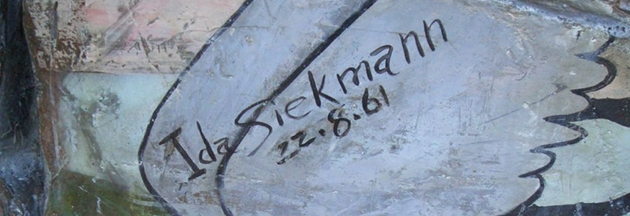After tens of thousands had fled East Berlin for West Berlin in recent months, the East Germans began to erect a physical barrier in the early morning of 13 August 1961. Thus began the Berlin Wall’s 28 year existence. As Germans and others celebrate — this year, 2009 — the 20th anniversary of the fall of the Wall, more attention will naturally be given as well to this anniversary of its construction.
I enjoy looking at archives to read through immediate reactions to such big historical events. I’ve looked today the U.S. State Department archives, specifically “Foreign Relations, 1961-1963, Volume XIV, Berlin Crisis, 1961-1962“.
An early telegram to Washington from the leader of the U.S. Mission in Berlin, Allen Lightner, speculated:
Evidently as a result of increased refugee flow with attendant economic loss to GDR and prestige to Socialist camp, East decided at recent Moscow conference of Warsaw Pact countries to proceed with fait accompli which would drastically disrupt freedom of movement within Berlin and erect frontier with respect entry into West Berlin of Sov Zone and East Berlin residents. In this way East has now taken some of the steps which it had been anticipated would follow from separate peace treaty with GDR.
As one would expect for such a momentous and dangerous event, the archives show a mix of reactions among U.S. diplomats. On 16 August, after three days of relative inactivity on the part of the west, Lightner’s telegrams show obvious frustration:
In essence these people feel that we are facing a crisis of confidence which endangers quite seriously our position. This is based on the absence of any sharp and definite followup action since the Secretary’s statement. However this feeling of letdown is the greater because the President’s speech had had such a large readership and television following and had evoked such widespread public acceptance as a promise of firmness. I have not been impressed by German complaints of the lack of display of US military presence since sector borders were closed. I realize also that the longstanding belief that US support is the main and only German protection makes them impatient of our desire to act in concert with NATO Allies. Taking into account these prejudices and discounting numerous emotional arguments which have been made to me I am nevertheless convinced that what is described as the surrender of East Berlin to Ulbricht with all that this immediately implies has been a shock so severe that it can gravely affect our future relations, first, with the city of Berlin and its leaders, and second with the Federal Republic once the extent of the disillusionment here is recognized in Bonn.
[…]
Comment: I anticipate Berliners will label our Aug 15 letter of protest belated and tepid. No one here asking large violent action, merely some action, some proof this is not “another sample of `Hitler’s take over of Rhineland'”. I think the timetable for this crisis has been stepped up very considerably and there is real danger that Berliners will conclude they should take themselves, their bank accounts and movable assets to some other place. What is in danger or being destroyed here is that perishable commodity called hope. [my emphasis]
Berlin Mayor and future German Chancellor Willy Brandt wrote to President Kennedy personally on 16 August to express his doubts about western reactions to the crisis:
This development has not changed will to resist of West Berlin population, but has tended to arouse doubts as to determination of three powers and their ability to react. In this connection the decisive factor is that the West has always specifically invoked the existing Four-Power status.
[…]
[I] recollect not without bitterness declarations rejecting negotiations with USSR on basis one should not negotiate under pressure. We now have state of accomplished extortion, and already I hear it will not be possible turn down negotiations. In such situation, when possibility of initiative for action is already so small, it is all the more important at least to demonstrate political initiative.
Among those located in Washington, you can see as early as 14 August, the day after construction began, the beginnings of the treatment of the event as a fait accompli as shown in McGeorge Bundy’s summary of his discussions with others:
The Department’s proposal for a riposte is likely to be the ending of the travel permits which have been issued by the three powers in West Berlin to East Germans who want to visit allied or neutral countries. This was used a year ago in response to East German harassment of civilian traffic, and it worked well. No one thinks it will cause a reversal of policy this time, in the light of the much more serious causes of this much larger action. But it is argued that it will give some pain, since it will cut off East German access to allied countries and to those neutral nations which play along.
I find this argument unconvincing. I doubt if we should take little actions in reprisal against this big one, especially when the punishment is unrelated to the crime. The only good argument for this action is that it has been discussed among the 4 Powers before as a possible retort to border-closing, and there may be some Allied worry about our “reliability” if we don’t support it now.
Incidentally, I find agreement in both Joe Alsop and George Kennan to these three conclusions: (1) this is something they have always had the power to do; (2) it is something they were bound to do sooner or later, unless they could control the exits from West Berlin to the West; (3) since it was bound to happen, it is as well to have it happen early, as their doing and their responsibility.
It reminds me of the opening pages of Rainer Eppelmann’s memoir, Fremd im eigenen Haus (Amazon US, UK, DE). Eppelmann’s father had papers showing him as being registered in West Berlin, whereas the family home was in the east. The parents agreed that the father should remain in the west (where work was more plenty):
Both [parents] were absolutely convinced that the Wall, erected brick-by-brick in front of the eyes of the world, would not remain for long. The West would never allow it! [My translation and emphasis]











